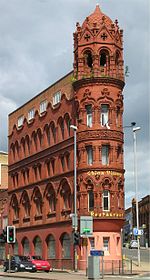St Chads tram stop

St Chads tram stop is a tram stop on the city-centre extension of Line 1 of the West Midlands Metro in the United Kingdom, adjacent to Snow Hill railway station. It opened on 2 June 2016 as part of the extension into Birmingham city centre as a replacement for the previous Snow Hill terminus tram stop. Initially named Snow Hill, it was renamed St Chads in January 2017, taking the name from the nearby St Chad's Cathedral, because on opening the necessary work to allow direct access with Snow Hill railway station had not been completed, and the Snow Hill name was considered confusing for passengers. Bull Street was instead advertised as the principal interchange, its platforms being closer to the main entrance of the rail station.When opened the stop could only be accessed by a walkway alongside the tracks from the city centre. Stairs and a lift connecting the stop to the street below were completed in September 2017. In December 2018 it was announced that a new entrance would be constructed at Snow Hill station, by opening up an arch in the railway viaduct. This will allow direct interchange between St Chads tram stop and Snow Hill railway station. The work was due to begin in Summer 2019.
Excerpt from the Wikipedia article St Chads tram stop (License: CC BY-SA 3.0, Authors, Images).St Chads tram stop
Queensway, Birmingham Jewellery Quarter
Geographical coordinates (GPS) Address Nearby Places Show on map
Geographical coordinates (GPS)
| Latitude | Longitude |
|---|---|
| N 52.484729 ° | E -1.900335 ° |
Address
Queensway
Queensway
B3 2PB Birmingham, Jewellery Quarter
England, United Kingdom
Open on Google Maps










